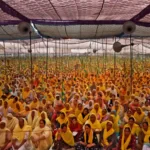Stubble burning in north India zone has long been a key causes of air pollution, but attempt to stop it fail every year.
And it’s more menacing this year with Covid-19 devastating the nation as pollution making humans much more at risk to infection and slow down their recovery. As per to few estimates, farmers in north India burning about million tonnes of paddy stubble each year.
Governments has been tried to stopped the regular practice. They have thrown out alternatives, they have banning it, they have fined farmers to continue to do it and they have even thrown a some of them in jail.
Mr Singh, who have not done it last year, was in hope to get this honour. We waited for a whole year, but we have got nothing,” he says. “So, like numerous another figures, I have determined to burn out the straw this time line.
Last year, the Punjab government confessed they couldn’t provided to pay so numerous farmers. “I don’t understand any farmer who has been reward this,” says ranbirdeep Grewal, a farmer.
As pollution levels progress, so has the gorge between the policy-makers and country’s farmers, who are try to fix a broken structure that has stimulus bulk production over the decades.
Experts say it’s part way due to plans that encouraging farmers to grown out more and not less. A spate of farmer-friend way decisions and reasonable subsidies in the 1960s turning Punjab and Haryana into India’s hugest contributors of meal grains.
But unlike then, India’s repository are no longer vacant and the system, which has changing little, is now at odds with straining attempts to clean up the air.
The solutions that has not stuck
What complicates matters is that farmers are a pivotal vote bank. That’s why court orders like heavy fines and bans often remained avoided. The politicians who want to enforce it will have to risk the thousands of farmers ire- which they would not do, says agricultural economist.
Meanwhile, farmers carry on with to avail heavy subsidies and free electricity on rice fertiliser.
The manners of farmers dependent on the policies you put into zones. Things like cheap fertilisers and free electricity causes havoc.
But farmers told they are getting the blame lion’s share, although their straw is only one of numerous origin of Punjabs air pollution. Others include dust, vehicular, and ignited and industrial emissions.
Weather plays a important role too. Farmers burning stubble twice a year – in summer and at the winter onset. The foremost time they do it, the warm breeze disperses it fast way. But the second time, in October or September, plunging temperatures and lower wind speed spreaded the smoke wide and far.
The Punjab government has tried out to offer alternative technology, but that comes up with its own share of issues.
But to moving forward, India might require to begin from the beginning. Or at least 1966, when Punjab, and Haryana were selected to lead the nations Green Revolution, which turbo-charged crop production by accepting modern high-yielding and technology seeds varieties.
More than 50 years on, research say such in-depth farming has not only led to the air pollution, but is likely to spark up other destructive consequences. Water tables in the punjab are exhausting rapidly – future generations are gazing at the water crisis.
Farmers registered this is insupportable but say they don’t have a choice as the government is not offer them successful solutions.
“Stubble burning is very damaging, we understand this,” he said, moments after lit up the fire. “But we don’t have an alternative. We do not have some kind of resources. The government only talking but doesn’t support. He declining to give his name before walk up into the misty distance.
Going by satellite photos, Sangrur has recorded the huggest incidence of stubble burn in Punjab this season, but it is scarcely an remote case.
The issue has been in a particular sharpened spotlight since 2013, when the AAP-led government came to power in New Delhi, and laboriously criticised Punjab and other near around states for burning stubble and contribute to the capital’s toxic pollution in the summer and winter.
Who understands, maybe this timeline, Punjab’s pollution probably not reaching Delhi! one farmer in the village of Punjab remarking with a titter.
But the budget did not involve a detailed breakdown of how this cash was to be spent. I emailed questions to party spokespersons and government, involving about the Punjab government’s plans for expenditure. As of the publication time, they had not answer.
Few farmers that they spoke with across the few villages had adopted certain of the solutions they had been offering for stubble burning, like biodecomposer capsules to breaking it down, but were unsatisfied with the outcome.








